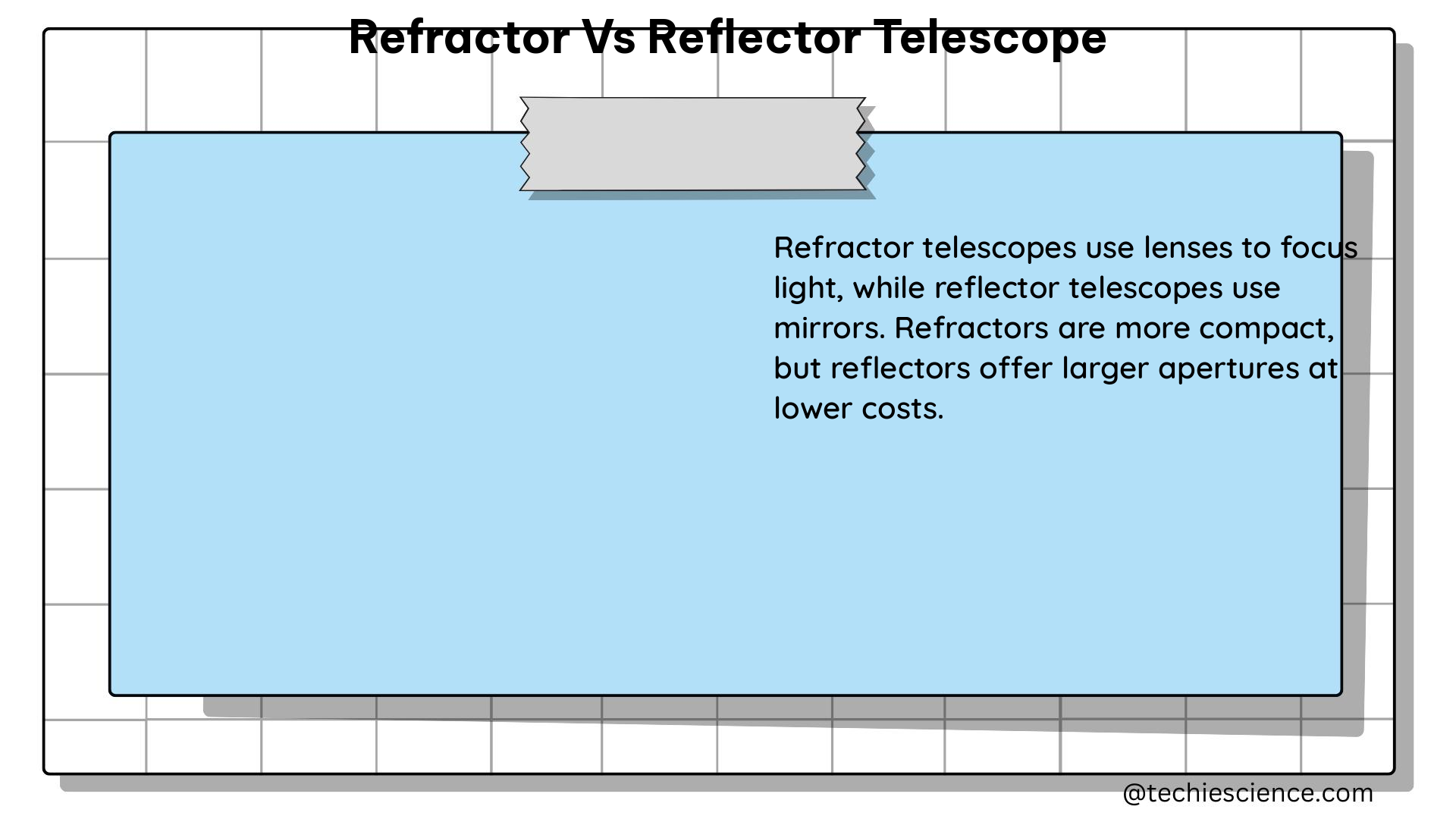Refractor and reflector telescopes are two distinct types of telescopes that have their own unique advantages and disadvantages when it comes to observing the night sky. In this comprehensive guide, we will delve into the technical details, physics principles, and quantifiable data that distinguish these two telescope designs, providing a valuable resource for physics students.
Aperture: The Key to Light Gathering Power
The aperture of a telescope, which is the diameter of the primary lens or mirror, is a crucial factor in determining the light-gathering power of the instrument. Refractor telescopes typically have smaller apertures compared to reflector telescopes, which means they collect less light. This difference in light-gathering power can be quantified using the formula:
Light-gathering power ∝ (Diameter of the telescope)^2
For example, a 20cm diameter telescope will collect four times as much light as a 10cm diameter telescope, as the light-gathering power is proportional to the square of the diameter.
Magnification: Theoretical Limits and Practical Considerations

The maximum useful magnification of a telescope is approximately 50 times the aperture in millimeters. This means that a 100mm refractor telescope can theoretically achieve a maximum useful magnification of 50 × 100 = 500x. However, the actual useful magnification is often limited by the quality of the optics and the atmospheric conditions.
It’s important to note that while reflector telescopes can achieve higher magnifications due to their larger apertures, the image quality may suffer from optical aberrations, such as spherical aberration, which can be minimized by using parabolic mirrors.
Chromatic Aberration: A Refractor’s Achilles’ Heel
Refractor telescopes can suffer from chromatic aberration, a type of optical distortion that causes different colors of light to focus at different points. This can result in colored halos around bright objects, such as the Moon or planets. To mitigate this issue, more expensive apochromatic lenses can be used, but even then, refractor telescopes may still exhibit some degree of chromatic aberration.
Spherical Aberration: A Challenge for Reflector Telescopes
Reflector telescopes, on the other hand, can suffer from spherical aberration, which occurs when light rays focus at different points depending on their distance from the center of the mirror. This can be minimized by using parabolic mirrors, which are more expensive to manufacture than spherical mirrors.
Contrast and Image Quality: Refractors Shine
While reflector telescopes generally have a greater light-gathering power, refractor telescopes often provide sharper and higher-contrast images of planets and the Moon. This is due to the inherent properties of the lens-based design, which can produce images with less distortion and better color fidelity.
Cost Considerations: Refractors Demand a Premium
Refractor telescopes are generally more expensive than reflector telescopes of the same aperture. This is because refractor telescopes require high-quality glass lenses, which are more difficult and expensive to manufacture than mirrors.
Numerical Examples and Calculations
- Maximum Useful Magnification:
- A 100mm refractor telescope has a maximum useful magnification of approximately 500x (50 × 100 = 500).
-
If a refractor telescope has an aperture of 60mm, its maximum useful magnification would be approximately 300x (50 × 60 = 300).
-
Light-Gathering Power:
- A 200mm reflector telescope has a light-gathering power four times greater than a 100mm refractor telescope, as the light-gathering power is proportional to the square of the diameter.
- If a reflector telescope has a diameter of 30cm, it will collect four times as much light as a refractor telescope with a diameter of 15cm (30^2 = 900, 15^2 = 225, 900 / 225 = 4).
Figures, Data Points, and Measurements
- A 100mm refractor telescope has a maximum useful magnification of approximately 500x.
- A 200mm reflector telescope has a light-gathering power four times greater than a 100mm refractor telescope.
- Refractor telescopes are generally more expensive than reflector telescopes of the same aperture.
Reference Links
- Telescopes and their limitations – Mr Toogood Physics
- Reflector vs. Refractor telescopes – Vaonis
- Refractor vs. Reflector Telescopes: What’s the Difference?
- Refractors vs Reflectors – Beginners Forum (No Astrophotography)
- Reflector vs refractor in terms of magnification, which one wins?
This comprehensive guide on refractor vs. reflector telescopes provides physics students with a detailed understanding of the technical aspects, physics principles, and quantifiable data that distinguish these two telescope designs. By exploring the aperture, magnification, optical aberrations, image quality, and cost considerations, students can make informed decisions when choosing the right telescope for their observational needs.

The lambdageeks.com Core SME Team is a group of experienced subject matter experts from diverse scientific and technical fields including Physics, Chemistry, Technology,Electronics & Electrical Engineering, Automotive, Mechanical Engineering. Our team collaborates to create high-quality, well-researched articles on a wide range of science and technology topics for the lambdageeks.com website.
All Our Senior SME are having more than 7 Years of experience in the respective fields . They are either Working Industry Professionals or assocaited With different Universities. Refer Our Authors Page to get to know About our Core SMEs.